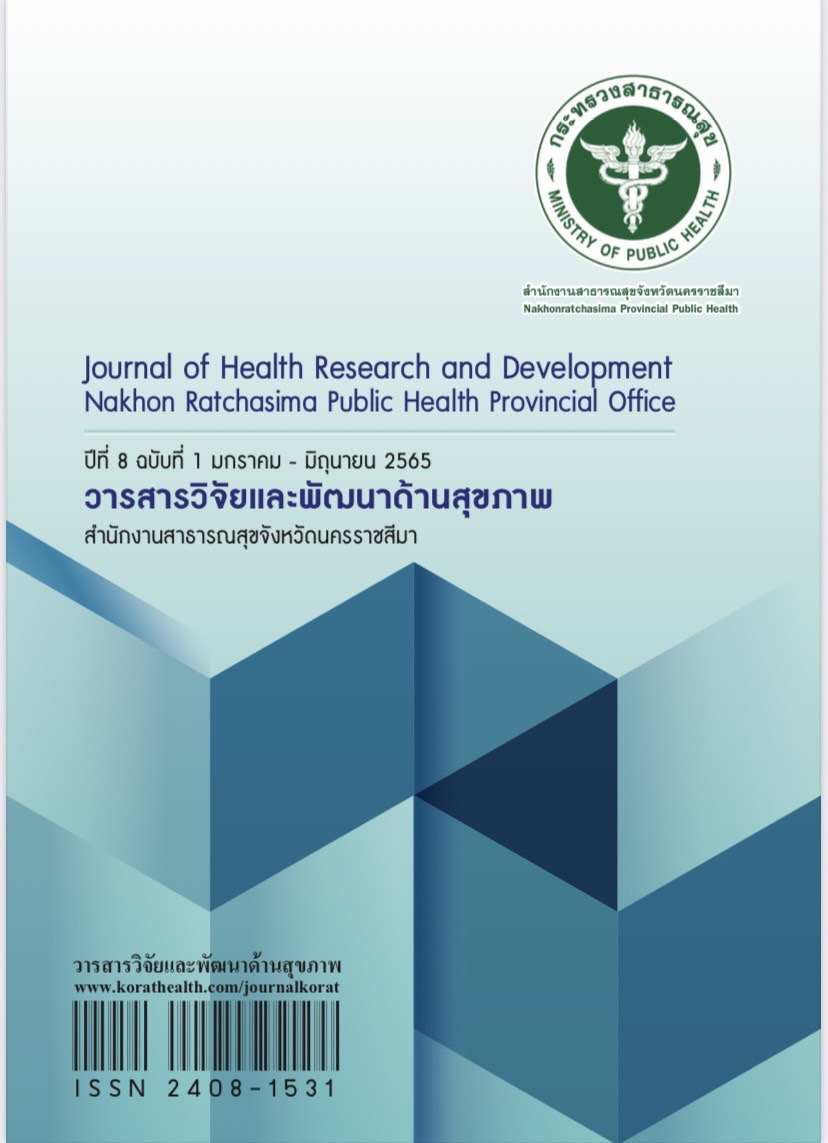ความรอบรู้ด้านสุขภาพในการใช้กัญชาทางการแพทย์ ของผู้ป่วยมะเร็งในภาคตะวันออกเฉียงเหนือ ของประเทศไทย
คำสำคัญ:
ความรอบรู้ทางด้านสุขภาพ, กัญชาทางการแพทย์, โรคมะเร็งบทคัดย่อ
การวิจัยเชิงวิเคราะห์แบบภาคตัดขวางครั้งนี้ มีวัตถุประสงค์เพื่อศึกษาความรอบรู้ด้านสุขภาพและปัจจัยที่มีความสัมพันธ์กับความรอบรู้ด้านสุขภาพในการใช้กัญชาทางการแพทย์ กลุ่มตัวอย่างที่ใช้ในการวิจัยครั้งนี้คือผู้ป่วยโรคมะเร็งที่อาศัยในเขตภาคตะวันออกเฉียงเหนือ จำนวน 1,193 คน โดยการสุ่มตัวอย่างแบบหลายขั้นตอน เก็บรวบรวมข้อมูลโดยใช้แบบสอบถาม วิเคราะห์ข้อมูลด้วยสถิติเชิงพรรณนาและสถิติ Multiple logistics regression ที่ระดับ 0.05 นำเสนอค่า Adjusted Odds Ratio พร้อมช่วงเชื่อมั่น 95% Confidence interval (CI) และ
p-value
ผลการศึกษา พบว่า กลุ่มตัวอย่างส่วนใหญ่เป็นเพศหญิง ร้อยละ 72.25 จบระดับประถมศึกษาร้อยละ 53.14 สถานภาพการสมรสคู่ ร้อยละ 74.27 ประกอบอาชีพเกษตรกรรม ร้อยละ 49.04 ในภาพรวมความรอบรู้ด้านสุขภาพในการใช้กัญชาทางการแพทย์อยู่ในระดับเพียงพอ ร้อยละ 53.48 สำหรับรายด้าน พบว่าด้านการเข้าถึงข้อมูล ด้านความเข้าใจ ด้านการวิเคราะห์ แปลความหมาย ประเมินข้อมูลสุขภาพ และด้านการตัดสินใจนำข้อมูลสุขภาพไปประยุกต์ใช้ อยู่ในระดับเพียงพอ ร้อยละ 45.85,
ร้อยละ 64.04, ร้อยละ 48.78 และร้อยละ 50.80 ตามลำดับ และปัจจัยที่มีความสัมพันธ์กับความรอบรู้ด้านสุขภาพในการใช้กัญชาทางการแพทย์อย่างมีนัยสำคัญทางสถิติ ที่ระดับ 0.05 ได้แก่ (1) เพศ (Adjusted OR=1.26, 95 % CI= 1.10 - 1.62; P-value =0.031) (2) รายได้เฉลี่ยต่อเดือน (Adjusted OR=2.10, 95 % CI = 1.60 - 2.69; P-value <0.001) (3) ทัศนคติต่อการใช้กัญชาทางการแพทย์ (Adjusted OR= 1.75, 95 % CI = 1.36 - 2.25; P-value <0.001) และ (4) การรับรู้ข้อมูลเกี่ยวกับกัญชาทางการแพทย์จากสื่ออินเทอร์เน็ต (Adjusted OR=2.20, 95 % CI = 1.67 - 2.80; P-value <0.001) ดังนั้น ควรเสริมสร้างความรอบรู้ด้านสุขภาพในการใช้กัญชาทางการแพทย์ของผู้ป่วยมะเร็ง รวมทั้งทัศนคติและช่องทางการรับรู้ข้อมูลเกี่ยวกับกัญชาทางการแพทย์
เอกสารอ้างอิง
World Health Organization [WHO]. Cancer. [online]. (2015). [cited 2017 May 5]. Available from: http://www.who.int/ mediacentre/factsheets/ fs297/en
Cheirsilp A. Epidemiology of cancer in Thailand. [online]. (2017). [cited 2017 Feb 19]. Available from: http://www. oocities. org/ suchartw/ epidermiology.html
Munson AE, Harris LS, Friedman MA, Dewey WL, Carchman RA. Antineoplastic activity of cannabinoids. J Natl Cancer Inst 1975; 55: 597 – 602.
Velasco G, Hernandez-Tiedra S, Davila D, Lorente M. The use of cannabinoids as anticancer agents. Prog Neuropsycho pharmacol Biol Psychiatry 2016; 64: 259 – 66.
Javid FA, Phillips RM, Afshinjavid S, Verde R, Ligresti A. Cannabinoid pharmacology in cancer research: A new hope for cancer patients? Eur J Pharmacol 2016; 775: 1 – 14.
Śledzińςki P, Zeyland J, Słomski R, Nowak A. The current state and future perspectives of cannabinoids in cancer biology. Cancer Med 2018; 7: 765 – 75.
Whiting PF, Wolff RF, Deshpande S, Di Nisio M, Duffy S, Hernandez AV, et al. Cannabinoids for medical use: A systematic review and meta-analysis. JAMA 2015; 313: 2456 – 73.
National Comprehensive Cancer Network. Antiemesis. [online]. (2018). [cited 2019 Jan 17]. Available from: https://www. nccnorg/professionals/physician_ gls/ default.aspx#antiemesis
Sorensen K, Van den Broucke S, Fullam J, Doyle G, Pelikan J, Slonska Z, et al. Health literacy and public health: A systematic review and integration of definitions and models. BMC Public Health 2012; 12: 80.
งานพัฒนาระบบคลังข้อมูล สำนักบริหารสารสนเทศการประกัน สำนักงานหลักประกันแห่งชาติ. สถิติผู้ป่วยมะเร็ง. กรุงเทพฯ: สำนักงานหลักประกันแห่งชาติ; 2562.
Hsieh FY, Bloch DA, Larsen MD. A simple method of sample size calculation for linear and logistic regression. Stat Med 1998; 17(14): 1623 – 34.
Saadeh CE, Rustem DR. Medical marijuana use in a community cancer center. JOP 2018; 14(9): 566 – 78.
Bloom BS. Handbook on formative and summative evaluation of student learning.
New York: McGraw-Hill; 1971.
Hee Yun Lee, Jiwoo Lee, Nam Keol Kim. Gender Differences in Health Literacy Among Korean Adults: Do Women Have a Higher Level of Health Literacy Than Men? American Journal of Men’s Health 2015; 9(5): 370 – 9.
Christian von Wagner, Katherine Knight, Andrew Steptoe and Jane Wardle. Functional health literacy and health-promoting behavior in a national sample of British adults. J Epidemiol Community Health 2007; 61: 1086 – 90.
Ji Yeon Park and Kyung Ja June. Influencing factors on functional health literacy among the rural elderly. Journal of Korean Academy of Community Health Nursing 2011; 22(1): 75 – 85.
Sudore, R. L., Mehta, K. M., Simonsick, E. M., Harris, T. B., Newman, A. B., Satterfield, S., . . .Yaffe, K. Limited literacy in older people and disparities in health and healthcare access. Journal of the American Geriatrics Society 2006; 54: 770 – 6.
R. V. Rikard1, Maxine S. Thompson, Julie McKinney and Alison Beauchamp. Examining health literacy disparities in the United States: a third look at the National Assessment of Adult Literacy (NAAL). BMC Public Health 2016; 16: 975.
Chengxiang Tang, Xueji Wu2, Xiongfei Chen, Bingying Pan2 and Xiaocong Yang. Examining income-related inequality in health literacy and health-information seeking among urban population in China. BMC Public Health 2019; 19: 221.
Maria João Silva, Paulo Santos. The Impact of Health Literacy on Knowledge and Attitudes towards Preventive Strategies against COVID-19: A Cross-Sectional Study. Environmental Health Research and Public Health. 2021; 18
Pernille Gabela,b, Mette Bach Larsena, Adrian Edwardsa,c, Pia Kirkegaarda and Berit Andersen. Knowledge, attitudes, and worries among different health literacy groups before receiving first invitation to colorectal cancer screening: Cross-sectional study. Preventive Medicine Report 2019; 14: 100876.
Hyejin Jung, Kirk von Sternberg and King Davis. The impact of mental health literacy, stigma, and social support on attitudes toward mental health help-seeking. International Journal of Mental Health Promotion; 2017.
Jennifer Manganello, Gena Gerstner, Kristen Pergolino, Yvonne Graham, Angela Falisi, and David Strogatz. The Relationship of Health Literacy with Use of Digital Technology for Health Information: Implications for Public Health Practice. JPHMP 2017; 23: 380 – 7.
David R. Hansberry, Nitin Agarwal and Stephen R. Baker. Health Literacy and Online Educational Resources: An Opportunity to Educate Patients. American Journal of Roentgen ology 2015; 204 : 111 – 6.
Gülsün Özdemir Aydına, Nurten Kaya and Nuray Turan. The Role of Health Literacy in Access to Online Health Information. Procedia - Social and Behavioral Sciences 2015; 195: 1683 – 7.
ดาวน์โหลด
เผยแพร่แล้ว
รูปแบบการอ้างอิง
ฉบับ
ประเภทบทความ
สัญญาอนุญาต
ลิขสิทธิ์ (c) 2022 สำนักงานสาธารณสุขจังหวัดนครราชสีมา

อนุญาตภายใต้เงื่อนไข Creative Commons Attribution-NonCommercial-NoDerivatives 4.0 International License.
บทความที่ได้รับการตีพิมพ์เป็นลิขสิทธิ์ของสำนักงานสาธารณสุขจังหวัดนครราชสีมา กระทรวงสาธารณสุข
ข้อความที่ปรากฏในบทความแต่ละเรื่องในวารสารวิชาการเล่มนี้เป็นความคิดเห็นส่วนตัวของผู้เขียนแต่ละท่านไม่เกี่ยวข้องกับสำนักงานสาธารณสุขจังหวัดนครราชสีมา และบุคลากรท่านอื่นๆในสำนักงานฯ แต่อย่างใด ความรับผิดชอบองค์ประกอบทั้งหมดของบทความแต่ละเรื่องเป็นของผู้เขียนแต่ละท่าน หากมีความผิดพลาดใดๆ ผู้เขียนแต่ละท่านจะรับผิดชอบบทความของตนเองแต่ผู้เดียว



